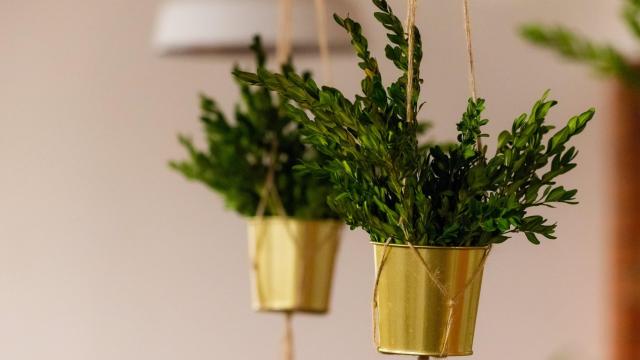Hanging plants are a great addition to your home, but watering them can be a hassle — especially if you have high ceilings. To save yourself the trouble, you can make a hanging system that allows you to lower plants easily to watering height and then raise them back up without any step stools required, and with no spilled water on the floor. Check out this TikTok to see it in action, and here’s more details on how to build your own.
What you’ll need for a hanging plant pulley
You’ll need some hardware and a strong cord for this project. For each plant, you’ll need two hooks (if you already have plant hooks in the ceiling, then you’ll only need one) and a length of cord that can reach from the ceiling to about waist level. To install your hooks properly, you’ll need a stud finder and a drill with a pilot bit as well. And it’s a good idea to choose a planter with a built-in drip tray to keep your floors dry.
How to install your plant pulley hardware
First, find a stud in the ceiling not too far from a wall where you can install your second hook. Drill a hole into the stud and screw in your ceiling hook. Then, find a stud in the adjacent wall and drill a hole within easy reach from the floor, and screw in your second hook.
Then, from the top of your plant hanger, tie one end of your chord securely. Thread the chord through the hook in the ceiling ,and pull on it until the plant reaches the ceiling. Tie a loop and put it on the hook on the wall. This will secure your plant at ceiling height. Then, lower your plant to watering height, tie a second loop, and hook it to the wall. This will secure your plant at watering height.
How to mark your loops
You can raise and lower your plant by unhooking the ceiling loop and lowering your plant to the watering height hook. You can use a sharpie or a little bit of electrical tape to mark one of the loops so that you can tell the difference on sight. You can also tie the watering height end of the cord to the hook on the wall securely instead of leaving an open loop, which will reduce the likelihood of mixing them up.
Be sure to hang your plants safely
To ensure that your chord doesn’t slip out of the hook in the ceiling, make sure that the opening of the hook is facing away from the wall. Also, of course, always secure your loops to the hook before letting go of the cord, or your plant will fall.
It’s also important to keep your ceiling hook fewer than two feet from the wall, as a greater distance from the wall makes for a more dangerous angle and it could become a hazard. This isn’t a good project for hanging plants in the middle of the room.

Leave a Reply
You must be logged in to post a comment.